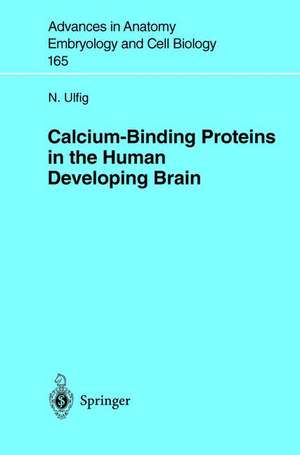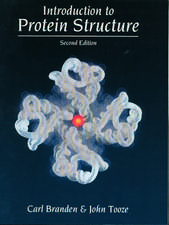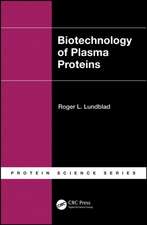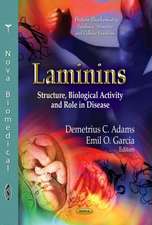Calcium-Binding Proteins in the Human Developing Brain: Advances in Anatomy, Embryology and Cell Biology, cartea 165
Autor N. Ulfigen Limba Engleză Paperback – 10 iul 2002
Din seria Advances in Anatomy, Embryology and Cell Biology
- 5%
 Preț: 1146.33 lei
Preț: 1146.33 lei - 5%
 Preț: 721.19 lei
Preț: 721.19 lei - 15%
 Preț: 637.13 lei
Preț: 637.13 lei -
 Preț: 381.81 lei
Preț: 381.81 lei - 15%
 Preț: 644.95 lei
Preț: 644.95 lei - 5%
 Preț: 1025.16 lei
Preț: 1025.16 lei - 15%
 Preț: 689.97 lei
Preț: 689.97 lei - 15%
 Preț: 577.07 lei
Preț: 577.07 lei - 15%
 Preț: 580.36 lei
Preț: 580.36 lei - 5%
 Preț: 393.51 lei
Preț: 393.51 lei -
 Preț: 408.66 lei
Preț: 408.66 lei -
![Die Schlüpfdrüse der Geburtshelferkröte (Alytes o. obstetricans [LAURENTI]) und anderer Froschlurche](https://i4.books-express.ro/bs/9783662239742/die-schluepfdruese-der-geburtshelferkroete-alytes-o-obstetricans-laurenti-und-anderer-froschlurche.jpg) Preț: 408.27 lei
Preț: 408.27 lei - 5%
 Preț: 1090.61 lei
Preț: 1090.61 lei - 5%
 Preț: 705.11 lei
Preț: 705.11 lei - 5%
 Preț: 706.04 lei
Preț: 706.04 lei - 5%
 Preț: 357.61 lei
Preț: 357.61 lei - 5%
 Preț: 704.59 lei
Preț: 704.59 lei - 5%
 Preț: 705.11 lei
Preț: 705.11 lei - 5%
 Preț: 359.42 lei
Preț: 359.42 lei - 5%
 Preț: 711.52 lei
Preț: 711.52 lei - 15%
 Preț: 635.47 lei
Preț: 635.47 lei - 15%
 Preț: 631.72 lei
Preț: 631.72 lei - 15%
 Preț: 633.35 lei
Preț: 633.35 lei - 15%
 Preț: 632.37 lei
Preț: 632.37 lei - 5%
 Preț: 706.60 lei
Preț: 706.60 lei - 15%
 Preț: 631.07 lei
Preț: 631.07 lei - 5%
 Preț: 707.13 lei
Preț: 707.13 lei - 5%
 Preț: 707.33 lei
Preț: 707.33 lei - 5%
 Preț: 359.60 lei
Preț: 359.60 lei - 5%
 Preț: 707.69 lei
Preț: 707.69 lei - 5%
 Preț: 707.13 lei
Preț: 707.13 lei - 5%
 Preț: 708.06 lei
Preț: 708.06 lei - 5%
 Preț: 706.41 lei
Preț: 706.41 lei - 5%
 Preț: 708.78 lei
Preț: 708.78 lei - 5%
 Preț: 705.68 lei
Preț: 705.68 lei - 5%
 Preț: 705.11 lei
Preț: 705.11 lei - 5%
 Preț: 706.77 lei
Preț: 706.77 lei - 15%
 Preț: 635.15 lei
Preț: 635.15 lei - 15%
 Preț: 631.07 lei
Preț: 631.07 lei - 5%
 Preț: 706.77 lei
Preț: 706.77 lei - 5%
 Preț: 706.04 lei
Preț: 706.04 lei - 5%
 Preț: 710.79 lei
Preț: 710.79 lei - 5%
 Preț: 705.32 lei
Preț: 705.32 lei - 15%
 Preț: 633.19 lei
Preț: 633.19 lei - 15%
 Preț: 629.09 lei
Preț: 629.09 lei - 15%
 Preț: 633.53 lei
Preț: 633.53 lei - 15%
 Preț: 632.70 lei
Preț: 632.70 lei - 15%
 Preț: 633.68 lei
Preț: 633.68 lei - 18%
 Preț: 773.72 lei
Preț: 773.72 lei - 15%
 Preț: 630.43 lei
Preț: 630.43 lei
Preț: 377.35 lei
Nou
Puncte Express: 566
Preț estimativ în valută:
72.22€ • 75.12$ • 59.62£
72.22€ • 75.12$ • 59.62£
Carte tipărită la comandă
Livrare economică 14-28 aprilie
Preluare comenzi: 021 569.72.76
Specificații
ISBN-13: 9783540434634
ISBN-10: 3540434631
Pagini: 108
Ilustrații: X, 96 p. 20 illus., 1 illus. in color.
Dimensiuni: 155 x 235 x 10 mm
Greutate: 0.16 kg
Ediția:Softcover reprint of the original 1st ed. 2002
Editura: Springer Berlin, Heidelberg
Colecția Springer
Seria Advances in Anatomy, Embryology and Cell Biology
Locul publicării:Berlin, Heidelberg, Germany
ISBN-10: 3540434631
Pagini: 108
Ilustrații: X, 96 p. 20 illus., 1 illus. in color.
Dimensiuni: 155 x 235 x 10 mm
Greutate: 0.16 kg
Ediția:Softcover reprint of the original 1st ed. 2002
Editura: Springer Berlin, Heidelberg
Colecția Springer
Seria Advances in Anatomy, Embryology and Cell Biology
Locul publicării:Berlin, Heidelberg, Germany
Public țintă
ResearchCuprins
1 Introduction.- 1.1 Calcium-Binding Proteins.- 1.2 CaBPs in the Mature and Developing Central Nervous System.- 1.3 Overview: Features of the Developing Brain.- 1.4 Scope of This Review.- 1.5 Materials and Methods.- 2 Cerebral Cortex: Subplate.- 2.1 Description.- 2.2 Expression of CaBPs in the Subplate.- 2.3 Functional Roles of the Subplate.- 2.4 Resolution of the Subplate.- 2.5 Effect of Fetal Hydrocephalus on the Distribution Pattern of CaBPs in the Subplate.- 2.6 Significance of the Subplate in Premature Infants.- 3 Cerebral Cortex: Cortical Plate.- 3.1 Description.- 3.2 CaBPs in the Cortical Plate.- 3.3 Effect of Fetal Hydrocephalus on the Distribution Pattern of CaBPs in the Cortical Plate.- 4 Cerebral Cortex: Molecular Layer (Layer I).- 4.1 Description.- 4.2 CaBPs in the Molecular Layer.- 4.3 Alterations in the Organization of Layer I in Trisomy 22.- 5 Ganglionic Eminence.- 5.1 Description.- 5.2 Developmental History.- 5.3 Neuronal Populations Originating from the Ganglionic Eminence.- 5.4 Calretinin and Calbindin Immunoreactive Cells in the Ganglionic Eminence and in the Intermediate Zone.- 5.5 The Ganglionic Eminence as an Intermediate Target.- 5.6 Significance of the Ganglionic Eminence in Developmental Neuropathology.- 6 Striatum.- 6.1 Description.- 6.2 Calbindin Expression in the Developing Striatum.- 6.3 Correlation of Calbindin Immunostaining and Expression of Synapse-Related Proteins in the Striatal Compartment of the Human Developing Brain.- 6.4 Significance of the Immunohistochemical Findings in the Striatum for Developmental Neuropathology.- 7 Amygdala.- 7.1 Description.- 7.2 Transient Architectonic Features of the Amygdala.- 7.3 Nerve Cell Types in the Fetal Amygdala as Seen in Calbindin and Calretinin Immunopreparations.- 7.4 Diffuse Calbindin and Calretinin Immunostaining in the Human Fetal Amygdala.- 8 Basal Nucleus of Meynert.- 8.1 Description.- 8.2 Calbindin Immunoreactive Neurons in the Basal Nucleus of Meynert.- 8.3 Effect of Fetal Hydrocephalus on Neuronal Morphology in the Basal Nucleus of Meynert.- 9 Hypothalamic Tuberomamillary Nucleus.- 9.1 Description.- 9.2 Parvalbumin and Calretinin in the Tuberomamillary Nucleus.- 10 Thalamic Reticular Complex.- 10.1 Description.- 10.2 Main Portion.- 10.3 Perireticular Nucleus.- 10.4 Medial Subnucleus.- 10.5 Pregeniculate Nucleus.- 10.6 Neuronal Types of the Thalamic Reticular Complex as Seen in Parvalbumin and Calretinin Immunopreparations.- 11 Red Nucleus.- 11.1 Description.- 11.2 Distribution Pattern of CaBPs in the Developing and Adult Red Nucleus.- 11.3 Relationship Between the Magnocellular and Parvocellular Parts.- 11.4 Neurochemical Characteristics of Rubric Nerve Cells.- 11.5 The Magnocellular Part of the Red Nucleus in the Adult Human Brain.- 11.6 The Magnocellular Part of the Red Nucleus in the Developing Human Brain.- 11.7 Significance of the Prominent Magnocellular Part for Neuropediatrics.- 12 Summary.- References.













